Exclusive Neurojet article: The construction industry stands as one of the largest economic sectors globally, with an annual turnover exceeding an impressive $10 trillion. Its sheer size underscores the challenges it faces, particularly in terms of cost reduction, increased efficiency, and the accelerated delivery of high-quality projects. Throughout its history, the construction sector has consistently sought innovations to address these challenges, and it is evident that emerging technologies are playing a central role in this transformation. These technologies are ushering in a new era of innovation and efficiency in the construction landscape.
The narrative of construction technology evolution is one steeped in human creativity. From ancient civilizations erecting magnificent structures to the industrial revolution mechanizing construction processes, innovation has been a consistent driving force. However, the current wave of technological advancements is nothing short of revolutionary. With unparalleled access to computing power and the internet, the construction industry has reached unprecedented heights.
Important Construction Technologies
Before we delve into the specific technologies shaping the construction sector, it is essential to establish what these innovations encompass. They are the result of a fusion of digital solutions, robotics, and data-driven insights, which are fundamentally altering the way structures are designed, built, and managed. These technologies span a broad spectrum of tools and methodologies, each targeting distinct challenges within the industry.
To gain an understanding of the magnitude of this transformation, consider some compelling statistics. According to industry reports, the global construction technology market is predicted to reach a substantial $334.2 billion by 2027, experiencing a notable compound annual growth rate of 12.6%. This remarkable growth reflects the increasing integration of technology within the sector. Furthermore, surveys reveal that nearly 76% of construction companies view the adoption of new technology as a fundamental component of their strategic vision, underscoring the industry’s growing technological proficiency.
Here’s the list of important technologies which shape our future:
1. 3D Printing
How about we tell you, anything you can imagine is printable? And if we add that this is done with minimal errors, without waste and construction waste, and at a lower cost? Yes, 3D printing is one of the technologies that seriously affects the construction industry, but it has led to transformations in many other industries.
With this technology, you can make the smallest and most accurate materials or parts of a construction project. You can also think of the complete and integrated construction of a bridge or a huge project. Let’s look at the amazing capabilities of this technology with examples.
In 2019, a construction company built a 3D printed spring-assisted office for the Dubai Municipality, which it claims is the largest 3D-printed building. This project has a height of 9.5 meters and an area of 640 square meters. This project is a big step forward in the concrete 3D printing industry.
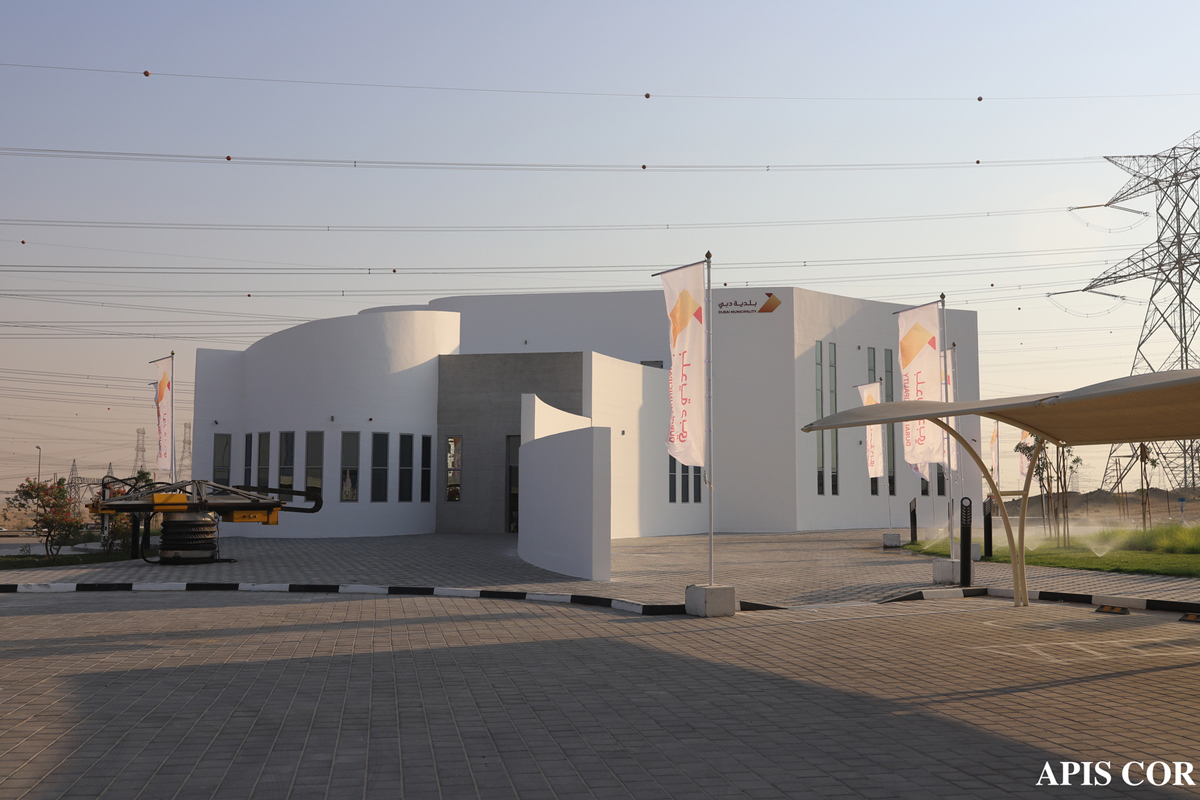
Another striking example is the house of the future in the United Arab Emirates. An office that will be the home of the Emirates Future Foundation. This office was built within 17 days of printing and in less than 48 hours at its designated place.

2. Artificial Intelligence (AI)
The construction industry is already seeing artificial intelligence implemented in the workplace. With AI in construction, automated construction equipment can work without human interaction and perform tasks such as bricklaying. This is one of the most promising emerging trends in civil engineering.
AI-driven construction systems improve accuracy, reduce costs, and promote safety on the job site. They also allow for faster project completion, making construction more efficient and cost-effective. This is why AI is becoming an increasingly significant part of the construction industry.
This is like the difference between performing a task manually versus using power tools; power tools can do the job much quicker and more efficiently, but require an understanding of how to use them and safety precautions.

Artificial intelligence can help construction projects by increasing safety, improving workflow, and getting things done faster and better. It can also detect when information or pieces are missing, ask questions, and use the data it collects.
For example, AI can be used to detect and monitor safety hazards, such as slips and falls, on construction sites. It can also be used to identify discrepancies between the design documents and the current state of the project.
3. Cloud and Mobile
Due to mobile phones’ daily use, we know their many advantages and opportunities, especially in communication. But what has changed with the introduction of cloud technology and how has the construction industry undergone serious changes? How did cloud technology reach 3.6 billion users in 2018? To answer this question, we must first learn more about cloud technology.
Traditionally, before the Internet and cloud technology, all our computer activities were stored on our own personal hardware and systems. This means that we needed a hard disk to store data, and we had limited storage capacity. We would definitely need to upgrade our system if we were to use software with high graphics or calculations. But thanks to cloud technology, the playing field has changed!

Now consider a giant collection of hardware connected and made available to you through the Internet. Almost unlimited capacity is provided by a hardware system. Dropbox, Google Drive, and Gmail provide this cloud space. You don’t lose files anymore. You have online and comprehensive access and work collaboratively and simultaneously with your colleagues.
In response to the question, what is cloud technology? The cloud is like having an extra hard drive in the sky, with infinite capacity that you can access from anywhere. With cloud storage, you no longer need to worry about losing data or having limited storage space on your computer.
Explaining the importance of cloud technology, construction industry consultant Brian Taammoli says: The big wave of Industry 4.0 is an excellent opportunity to digitize construction practically. Any general contractor that can navigate the Internet of Things will play a significant role in the industry’s future. The construction industry is currently in high demand for cloud-based platforms that provide APIs for data integration and utilization.
But what is the use of cloud and mobile technology in the construction industry? The first benefit is improved communication and job productivity on construction sites. Project management and wide accessibility, storing documents and sharing them, using wearable tools to track workers’ health and safety, predicting delays in the construction process, and predicting accidents using machine learning are other advantages that are used by construction industry activists.
For instance, AI-based scheduling systems can analyze project data to identify trends and recognize patterns in the construction process, allowing project managers to anticipate potential delays or issues and take preemptive measures to mitigate their impact.
4. Drones or Unmanned Aerial Vehicles (UAVs)
Drones or unmanned aerial vehicles are increasingly used to survey or inspect construction sites, monitor progress, and track safety compliance. They can also capture video footage, provide 3D maps, and enable remote operations. Drones in construction can improve workplace safety, reduce time and costs, and improve data collection accuracy. In the following, we discuss some applications for drones and aerial vehicles.
Security Monitoring
According to the National Equipment Registry, more than $300 million worth of construction equipment is stolen every year, and less than 25% can be recovered. By providing 24-hour surveillance, drones can prevent mechanical lift or shovel theft that costs hundreds of thousands of dollars.
Topographic Mapping
Examining topographic maps in large and complex construction projects is very critical. Paying attention to these maps can prevent costly design mistakes. Previously, access to an up-to-date topographic map was only possible with money and time. But thanks to technology, drones have greatly reduced the speed, accuracy, and cost of such work. Additionally, the high resolution of the drone images enables us to model the 3D topography and maps of that map and plan accordingly immediately.
Inspection of Building Operations
Drones can record errors and defects by tracking construction equipment. The simultaneous development of drones and artificial intelligence in the not-too-distant future will provide the conditions for vehicle management and guidance.
Photography and Documentation
Another advantage of drones in construction is related to this issue. Documenting the construction process and photographing it to present and display the work results and the process followed. Something primitive and incomplete without drones.
Remote Monitoring of Progress
The use of drones provides contractors, owners, workers, construction managers, design teams, and engineers with the possibility to monitor the work process closely without being continuously present at the project site, and with the complete coverage they have of the work process. Prevent possible errors.
Undoubtedly, drones are one of the most prominent trends in construction, growing by 239% last year! These drones, or unmanned aerial vehicles, have completely revolutionized the process of tracking building progress. They provide real-time updates and review projects through photos, videos, and images.
Suggested article for reading: Construction Monitoring Solutions: Your Complete Guide
Worker Safety
More than 30% of worker deaths are based on falls on construction projects. At the time of measurement, workers had to climb onto unstable platforms, which posed life risks. The drone now provides this work in a very simple way. Also, managers can use this technology to monitor and check safety compliance with their workers.
5. Virtual reality (VR) in
Through the use of this technology, architects, designers, contractors, and engineers can prepare for such a costly project before it begins. Walk inside the design project and see all its details clearly. This means a better understanding of the project, the elimination of possible future errors, and a more common understanding among its stakeholders.

As we discussed earlier, VR technology now allows us to use BIM to achieve this goal. After designing the project and synchronizing it with the virtual reality system, having its own headset and glasses, one can get such an exciting and useful experience in the construction industry.
This will reduce time and costs while providing a better and more accurate result. Additionally, virtual reality in construction makes it easier for clients to visualize the final product and make decisions faster.
6. Augmented Reality (AR)
Augmented reality is more than images inside digital devices. A fact that can be seen and understood with a tablet or smart phone. For example, if you place your smartphone in front of a building plan, this technology can help you see the 3D plan of the building. This will enable you to understand the building built on this plan. In fact, this technology combines virtual reality produced by the user in the real world with virtual reality.
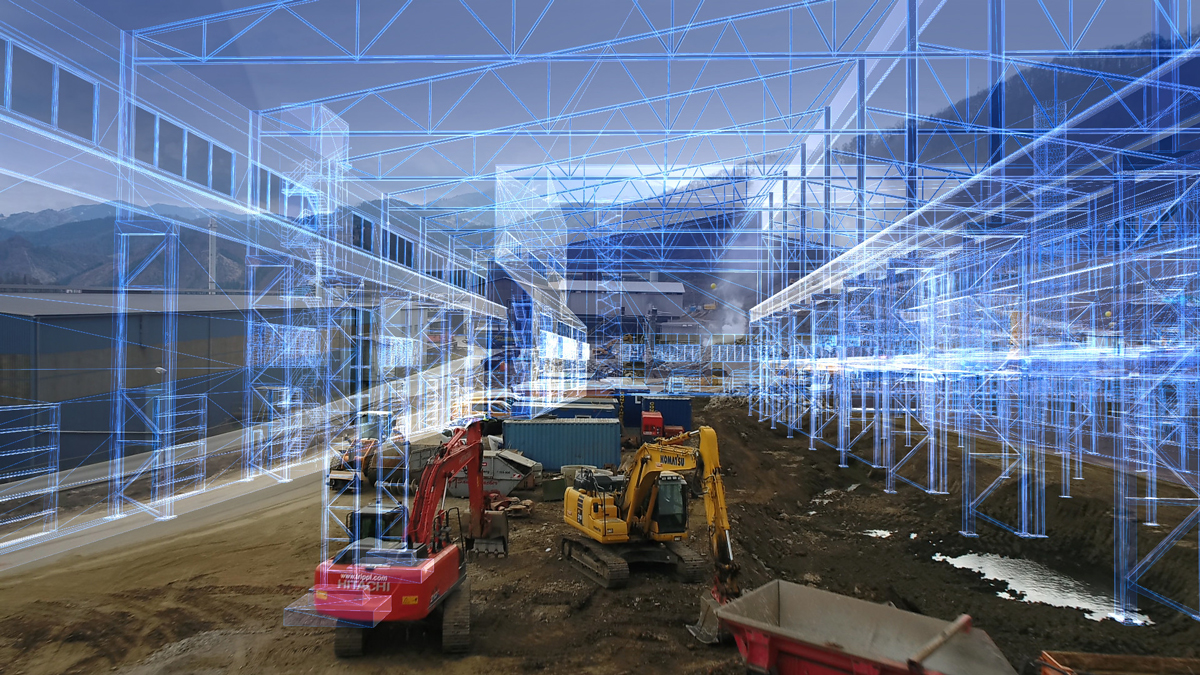
Augmented reality or AI in construction industry is a serious development that grows as one of the technology trends in the industry. In general, this technology is used in project planning, displaying the design before construction and finalizing it. It also measures spaces automatically, evaluates improvements to different parts of construction projects, displays layered project information on site, training, more collaboration, and is used more interactively.
7. Building Information Modeling (BIM)
Let’s start the explanation and definition of BIM with a sentence from Autodesk, a pioneer in this field: Building Information Modeling (BIM) is the foundation of digital transformation in the architecture, engineering, and construction industries. The building information modeling market is projected to reach USD 10.7 billion by 2026, growing at a rate of 12.5% during the forecast period.
But what is BIM or building information modeling? It is a comprehensive and integrated process based on an intelligent 3D model that is used to manage and create project information in construction. Through a digital output, this process provides architecture, construction, and engineering (AEC) professionals with insight and tools to design, build, and manage infrastructure more efficiently.
Before moving on to more applications of this technology, it may be useful to review its use statistics in different industries. According to an Autodesk report, 60% of architects, 51% of structural engineers, 46% of civil engineers, and 41% of contractors use this technology in their projects. This is expected to grow in the coming years.

BIM is used in various industries and activities such as planning, design, construction, operation, and maintenance. It is also used in various infrastructures such as water, electricity, gas, garbage, communication facilities, roads, railways, bridges, etc. But if we want to address building information modeling applications, you will generally face these things:
- Structure Analysis and Design: Infrastructures such as bridges and subway stations are used for structural analysis and design.
- Visualization of the Project: to find defects before construction, which now also includes AR and VR.
- Architectural Design: Parametric designs and other complex architectural design solutions are possible. It also helps you to find different design variations by providing parameters. This makes architectural design faster and more efficient.
- Facility Management: The seventh dimension of BIM is a digital copy of a real building used for facility management.
- Construction Drawings: Serve the purpose of generating information that allows the manufacturer to advance the project execution process as efficiently as possible.
- Cost Estimation: the fifth dimension of BIM that estimates construction costs and helps contractors manage their construction process according to the budget.
- Planning and Scheduling: the fourth dimension of fear, which reduces time uncertainties.
- MEP Design: BIM engineering helps MEP engineers design and model mechanical, electrical, plumbing, and fire services with conflict resolution and coordination.
- Building Sustainability: BIM helps to complete the construction process faster, safer, and with less waste. It also helps significantly to make it cheaper and more sustainable.
- Project Lifecycle Management: Faster workflow by connecting teams and collecting data.
8. Internet of Things (IoT)
The Internet of Things (IoT) stands as a powerful catalyst for transforming industries, streamlining processes, and enhancing Return on Investment (ROI). Among the sectors ripe for this transformation, the construction industry emerges as a promising candidate. IoT technology holds substantial potential for bolstering productivity, operational efficiency, and on-site safety within construction. By deploying IoT sensors and devices, companies can achieve real-time visibility and improvements at all phases of construction projects, extending their benefits even to post-construction operations.
As per findings from the Global Construction Survey, an impressive “76% of construction business operators view the adoption of new technology as an integral part of their strategic planning and vision.” This includes various IoT implementations. Given the rapidly changing landscape of the construction industry, firms incorporating IoT solutions can effectively address typical workplace challenges while reaping a multitude of advantages. IoT empowers these companies to remain agile in response to the industry’s ever-evolving demands.
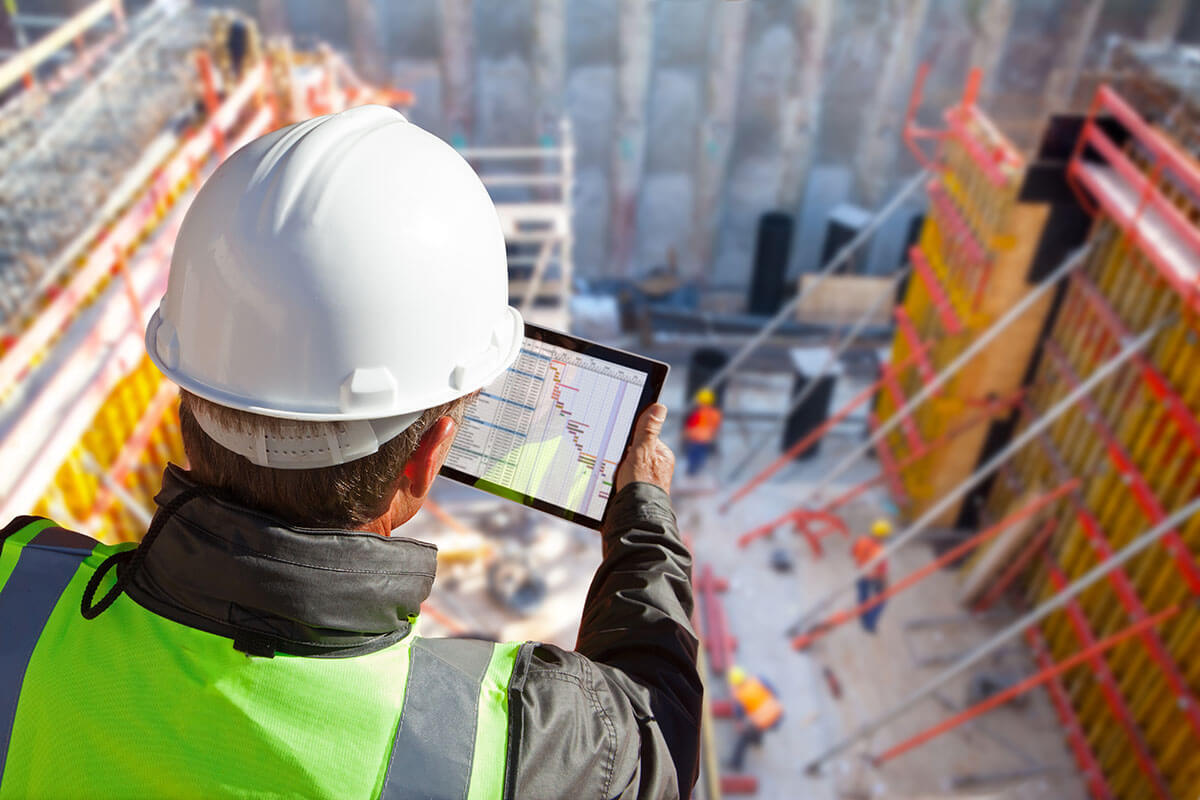
The IoT’s influence on construction extends across five key applications:
- Wearables: Wearables, such as smart helmets and connected work boots, have become familiar and invaluable IoT tools in construction. They bolster safety and efficiency by alerting workers to potential hazards, monitoring vital signs to prevent overexertion, and providing location features for workforce management.
- Safety Sensors: On-site and on-vehicle safety sensors play a similar role in enhancing construction site safety. These devices offer insights into worker safety, monitor equipment for maintenance needs, and track environmental conditions to prevent accidents.
- Material Monitoring: IoT devices are utilized to monitor construction materials, with concrete sensors being a prominent example. They provide real-time insights into the curing process, helping optimize project timelines and offering post-completion infrastructure monitoring for early issue detection.
- Theft Prevention: IoT-driven theft prevention tools include connected drones that patrol worksites, deterring potential thieves and aiding in the recovery of stolen equipment. Location sensors in vehicles and tools transmit real-time location data, assisting in asset recovery.
- Waste Management: IoT technologies are harnessed to manage and minimize waste in construction operations. By tracking usage patterns, construction teams can optimize fuel and energy consumption. IoT sensors also monitor on-site waste levels, fostering efficiency, safety, and waste reduction.
The adoption of IoT technologies in construction signifies a significant step towards a safer, more efficient, and sustainable industry. These applications promise to address longstanding challenges and elevate construction practices to new levels of productivity and sustainability.
Suggested articles to read: The Ultimate Guide to IoT Sensor | What is IoT in Construction?
9. Robotics
Rapid developments in construction robotic technology are transforming the industry, making science fiction-like scenarios a reality. While they won’t entirely replace human labor, robots are enhancing construction in various ways.
- Collaboration: Robots will work alongside human labor, improving efficiency, safety, and productivity. As labor shortages persist, robots are increasingly handling repetitive tasks, enabling human workers to focus on more complex aspects of their jobs.
- Key Players: Construction Robotics has pioneered the Semi-Automated Masonry (SAM) System and the Material Unit Lift Enhancer (MULE). SAM collaborates with masons, automating bricklaying tasks like lifting, mortar application, and placement, while masons oversee accuracy and quality. MULE assists in lifting and placing heavy materials on-site, boosting productivity and safety.
- Hadrian X: Developed by Fastbrick Robotics, this bricklaying robot can lay 1,000 bricks per hour and construct entire houses in just two days. It includes provisions for electrical, plumbing, doors, and windows.
- Construction Layouts: Innovations like Dusty Robotics’ FieldPrinter and Theometrics’ layout robot use CAD drawings or BIM models to navigate construction sites, performing layout and measurement tasks.
- Demolition Robots: Demolition robots are gaining popularity, enhancing safety and efficiency in construction. Brokk, Finmac, and Husqvarna offer remote-controlled solutions that prevent accidents involving heavy machinery and monitor on-site hazards.
- Self-Driving Trucks & Heavy Equipment: Royal Truck & Equipment Co. has partnered with companies like Micro Systems and Kratos Defense to develop autonomous crash trucks. They enhance road construction worker safety in highway work zones and can operate remotely, via GPS navigation, or by following a lead vehicle.
- Built Robotics: Built Robotics’ Automated Track Loader (ATL) excels in excavating small construction sites. It utilizes LiDAR technology to adapt to vibrations, measure excavated material, and maintain accuracy. Augmented GPS and collision detection features ensure worker safety and precision.
- Smart Construction: Companies like Komatsu employ IoT technologies in their Smart Construction and Intelligent Machine Control (IMC) equipment. Automatic blade control and real-time blade position information are standard. Skycatch drones generate 3D terrain models for accurate construction designs.
- Jobsite Monitoring: Doxel AI uses robots and artificial intelligence for real-time progress monitoring. Autonomous drones and rovers equipped with cameras and LiDAR technology capture detailed daily images and scans of the construction site. Doxel AI compares these scans to BIM models, schedules, and estimates, inspecting work quality and tracking daily progress. Deep-learning algorithms identify errors, discrepancies, and deviations from plans.
- Rebar Work: TyBot, developed by Advanced Construction Robotics, automates rebar tying with minimal human supervision. It improves productivity and reduces worker strain on construction sites.
- Transformation: The integration of robots into construction practices promises a new era of efficiency, safety, and innovation. These developments address challenges and redefine the future of construction.
The construction industry is undergoing a revolutionary transformation driven by advances in robotic technology. These innovations are quickly turning science fiction-like scenarios into reality. Robots are becoming a staple on construction sites, working collaboratively with human labor to enhance various aspects of the construction process.
Suggested article to read: Construction Robots
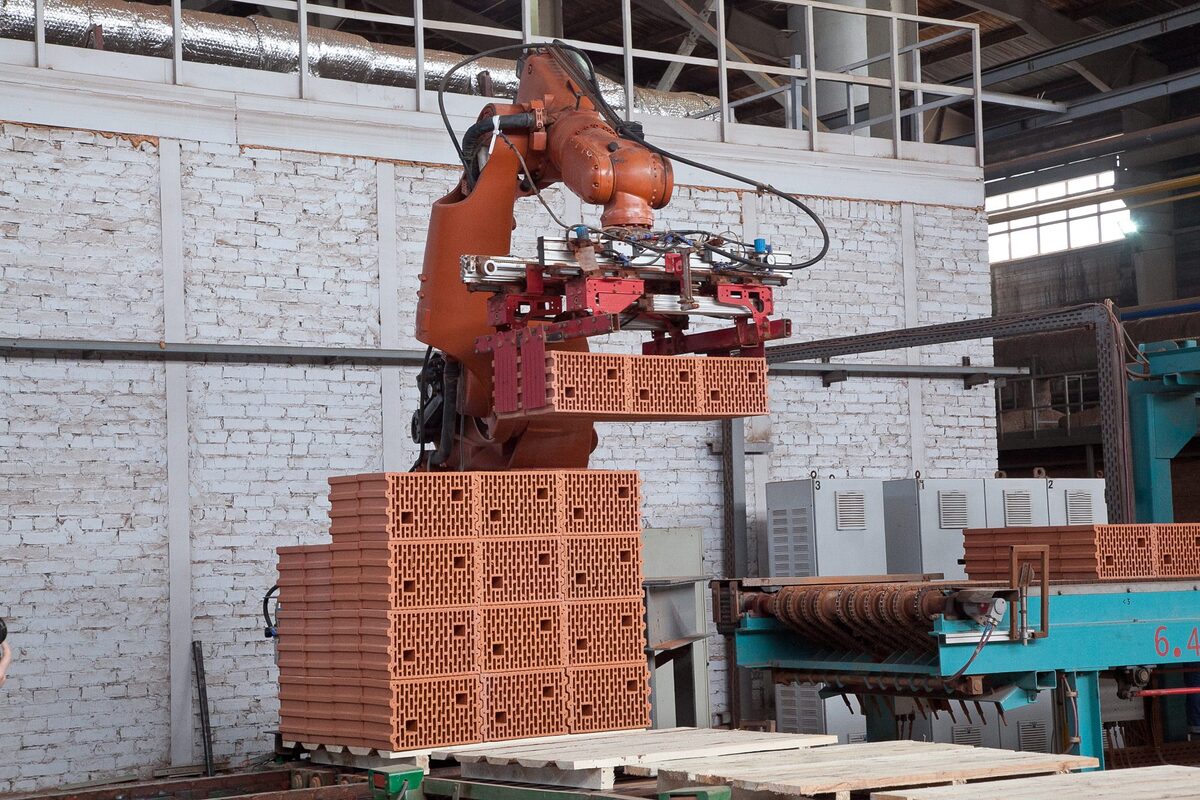
Notable Innovations
Here’s the list of its innovations in construction sector:
- Collaboration: Robots and human workers are working side by side, with robots handling repetitive tasks and allowing humans to focus on more complex aspects of their jobs.
- Construction Robotics: Construction Robotics, a key player in this field, has introduced the Semi-Automated Masonry (SAM) System. SAM works in conjunction with masons, automating bricklaying tasks, from lifting bricks to applying mortar. The Material Unit Lift Enhancer (MULE) assists in lifting and placing heavy materials on-site, enhancing productivity and safety.
- Hadrian X: Developed by Fastbrick Robotics, the Hadrian X is a remarkable bricklaying robot. It can lay an impressive 1,000 bricks per hour and construct complete houses in a mere two days, complete with provisions for electrical, plumbing, doors, and windows.
- Construction Layouts: Dusty Robotics’ FieldPrinter and Theometrics’ layout robots utilize CAD drawings or BIM models to navigate construction sites and perform precise layout and measurement tasks.
- Demolition Robots: Robots designed for demolition tasks are increasingly being used in construction. Brands like Brokk, Finmac, and Husqvarna offer remote-controlled solutions that improve safety and efficiency by preventing accidents and monitoring on-site hazards.
- Self-Driving Trucks & Heavy Equipment: Autonomous crash trucks are improving road construction worker safety, with companies like Royal Truck & Equipment Co. partnering with technology firms for their development.
- Built Robotics: Built Robotics introduces the Automated Track Loader (ATL), designed for excavating small construction sites. It uses LiDAR technology to adapt to vibrations, ensuring precise material measurement. Augmented GPS and collision detection features enhance safety and accuracy.
- Smart Construction: Industry giants like Komatsu leverage IoT technologies for their Smart Construction and Intelligent Machine Control (IMC) equipment. These machines offer automatic blade control and real-time blade position information for precise construction work. Skycatch drones provide accurate 3D terrain models for construction planning.
- Jobsite Monitoring: Doxel AI deploys autonomous drones and rovers equipped with cameras and LiDAR technology to capture daily images and scans of construction sites. These scans are then compared to BIM models, schedules, and estimates, allowing for real-time progress monitoring. Deep-learning algorithms identify errors and discrepancies, enabling rapid correction and avoiding costly rework.
- Rebar Work: TyBot, developed by Advanced Construction Robotics, is revolutionizing rebar tying. With minimal human supervision, it can continuously tie rebar, enhancing productivity and reducing worker strain on construction sites.
These innovations are reshaping the construction industry, offering unprecedented levels of efficiency, safety, and innovation. Robots are now integral to construction processes, addressing long-standing challenges and redefining the future of the industry.
10. Modular Construction
Modular construction is a method where a structure is built in a controlled plant environment, employing the same materials, and adhering to identical codes and standards as traditionally constructed buildings.
The key advantage is that it significantly reduces construction time, typically taking about half as long. This process involves creating individual “modules,” which, when assembled on-site, faithfully replicate the original design and specifications of a high-quality conventionally built structure, without any compromises.
Modular construction, which involves fabricating building components in a controlled off-site environment and subsequently assembling them on the project site, presents a multitude of advantages that render it an appealing option for diverse construction endeavors. Below are some primary benefits associated with modular construction:
- Accelerated Construction: One of the most notable merits of modular construction is its remarkable swiftness. Structures can be finalized in nearly half the time in comparison to conventional building approaches. The concurrent work conducted both on-site and off-site significantly trims project timelines.
- Cost-Effectiveness: Modular construction can yield financial savings. The efficient, controlled factory setting minimizes material wastage, while assembly line production can lead to reduced labor expenses. Furthermore, the abbreviated construction schedules translate to lower financing and overhead costs.
- Stringent Quality Control: The regulated factory environment ensures unwavering quality. Each module adheres precisely to stipulated specifications, and thorough quality assessments are carried out throughout the manufacturing process. Consequently, this results in a reduction of defects, rework, and delays.
- Mitigated Disruption: On-site construction often entails disturbances for neighboring residents, businesses, and the environment. Modular construction mitigates on-site disruptions by relocating a substantial portion of the work off-site. This is particularly advantageous in urban or densely populated areas.
- Enhanced Safety: Safety holds paramount importance in modular construction. The factory setup reduces the likelihood of on-site accidents and weather-related incidents, which have the potential to induce delays and pose risks to personnel in traditional construction.
- Environmental Sustainability: Modular construction frequently leads to diminished material wastage through meticulous planning and production. Additionally, the controlled environment facilitates improved recycling and material reuse. Transportation of modules is executed more efficiently, thereby reducing carbon emissions.
- Design Versatility: Modular construction fosters design flexibility, granting architects and designers the latitude to create inventive and distinctive structures. Modules can be tailor-made to align with particular project requirements, ensuring the ultimate product aligns with the design intent.
- Uniformity: All modules within a project are fashioned in adherence to identical standards, ensuring uniformity in design, materials, and quality. Achieving such consistency proves to be a formidable challenge with traditional construction techniques.
- Scalability: Modular construction exhibits high scalability. It applies to projects of various dimensions, spanning from petite residential units to expansive commercial and industrial edifices. The process is adaptive to cater to divergent needs and varying project intricacies.
- Energy Efficiency: Modular buildings often incorporate energy-efficient designs and materials, complying with or surpassing energy efficiency benchmarks. This translates to decreased operational expenses over the building’s lifecycle.
- Adaptability: Modular buildings are not constrained to specific applications. They can be deployed across a spectrum of functions, encompassing residential, commercial, healthcare, education, and more. Their adaptability renders them a versatile choice for numerous industries.
- Reduced Weather Sensitivity: Owing to a substantial portion of the construction taking place indoors, modular construction is less susceptible to adverse weather conditions, thus curtailing the likelihood of weather-related delays and their accompanying costs.
In summary, modular construction furnishes a plethora of advantages, positioning it as an efficient, cost-effective, and sustainable alternative to conventional building methods. Its capacity to streamline the construction process, elevate quality control, and curtail costs renders it an increasingly favored choice for a diverse array of construction projects.
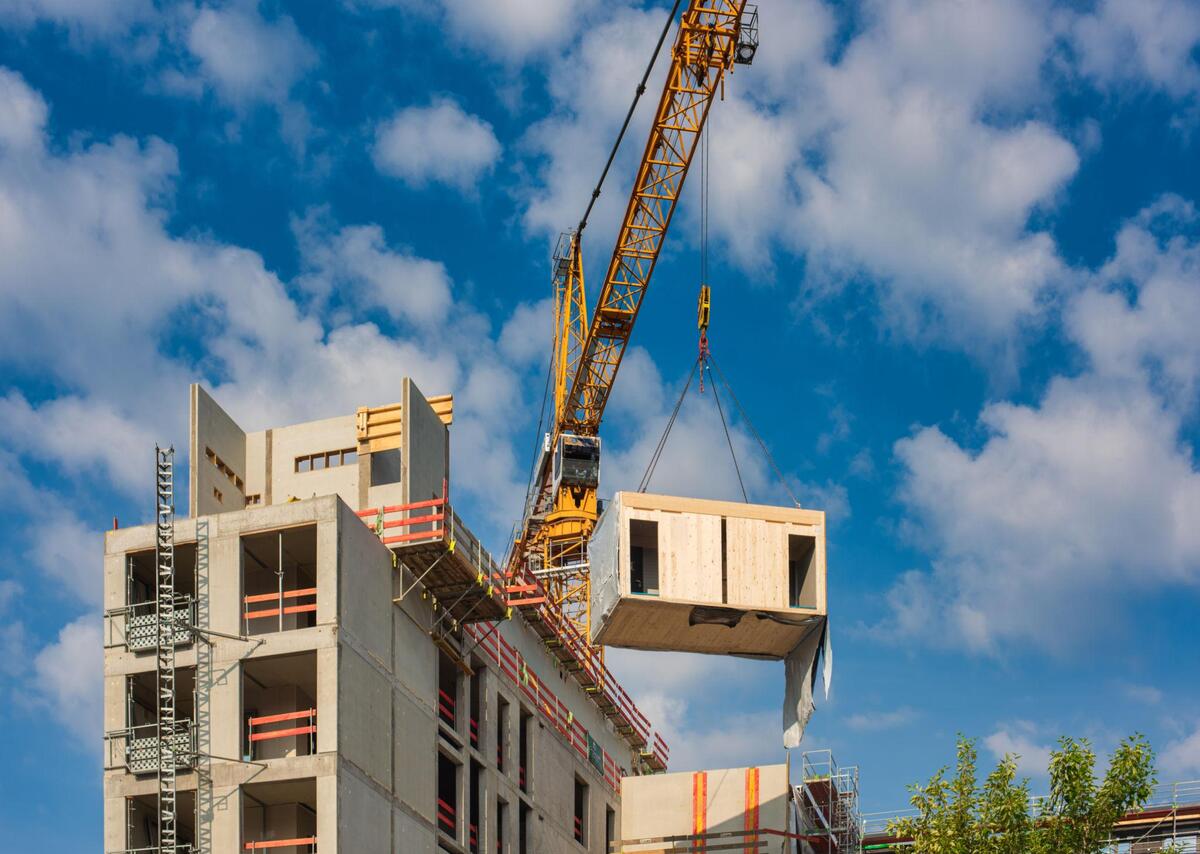
11. Blockchain
Blockchain is essentially a chain of data “blocks” forming a decentralized ledger, akin to a self-balancing checkbook, which houses transactions or project contracts. Picture it as a literal chain, with each link representing an individual project transaction. When a supplier fulfills their contract and delivers goods or services, it’s akin to adding a new “block” or link in this chain. This inherent structure lends blockchains an intuitive order for easy information retrieval.
The fundamental principles of blockchain underscore its attributes as secure, decentralized, and adaptable to projects of any scale:
- Security: It employs multilayer encryption through mathematical functions, obscuring data within a complex string of characters, rendering it challenging to decipher.
- Decentralization: Blockchain relies on connections termed “nodes” that autonomously validate transactions, creating an immutable digital record of verified records.
- Scalability: As blockchain data isn’t confined to a central server, it can seamlessly expand to suit even extensive projects.
Suggested article to read: Blockchain in Construction
Implementing Blockchain in the Construction Sector involves the following steps:
- Identifying Use Cases: The first step involves identifying suitable use cases in construction, focusing on areas where blockchain’s attributes of transparency, traceability, and automation can alleviate inefficiencies. Potential applications span supply chain management, payment processing, contract administration, and document verification, among others.
- Selecting the Appropriate Blockchain Platform: Choosing the right blockchain platform is paramount for a successful implementation. Factors like scalability, security features, consensus mechanisms, interoperability, and community backing should guide this decision. Depending on the specific needs of a construction project, options range from public blockchains such as Ethereum to private or consortium blockchains like Hyperledger Fabric.
- Establishing a Consortium or Private Blockchain: Construction firms must decide between consortium and private blockchains, depending on the desired level of collaboration. While private blockchains cater to a single entity, consortium blockchains involve multiple firms jointly leveraging the blockchain infrastructure. This step necessitates determining the intended degree of centralization and control.
Integration with Existing Systems: For a seamless transition, integrating blockchain with current systems and processes is imperative. This entails identifying interaction points, implementing data exchange protocols, and creating APIs or middleware to ensure an efficient flow of information and prevent disruptions in ongoing construction projects.
Conclusion
The construction industry, with its annual turnover exceeding $10 trillion, stands as one of the world’s largest sectors. The need for cost reduction, increased efficiency, speed, and quality in construction and project management is undeniable. Achieving these goals has become increasingly reliant on technology and emerging technologies.
This article has delved into ten pivotal construction technologies that are reshaping the industry. From 3D printing and artificial intelligence to the cloud, drones, virtual reality, augmented reality, Building Information Modeling (BIM), the Internet of Things (IoT), robotics, and modular construction, each technology offers unique advantages. They enhance efficiency, safety, and sustainability in construction practices.
The adoption of these technologies is not only driving innovation but also improving the construction industry’s ability to address long-standing challenges and demands. The accelerated construction timelines, reduced costs, and enhanced quality brought about by these technologies have the potential to reshape the industry profoundly.
As we stand at the intersection of technology and construction, the choices made in embracing these innovations will determine the industry’s future trajectory. The rapid evolution of these technologies underscores the importance of staying abreast of emerging trends and harnessing their potential to create a more efficient and sustainable construction landscape. The future of construction holds immense promise, with these technologies serving as key enablers of transformation and progress. It is now time to seize the opportunities and make the most of the technology-driven revolution in the construction sector.
Suggested articles for reading:
Lean Construction Principles and Practical Examples
Top 7 Sustainable Architecture Projects
Resources:
IoT for all | Modular Building Institute | Construction Connect | BigRentz
For all the pictures: Freepik | PBC Today | decofice





